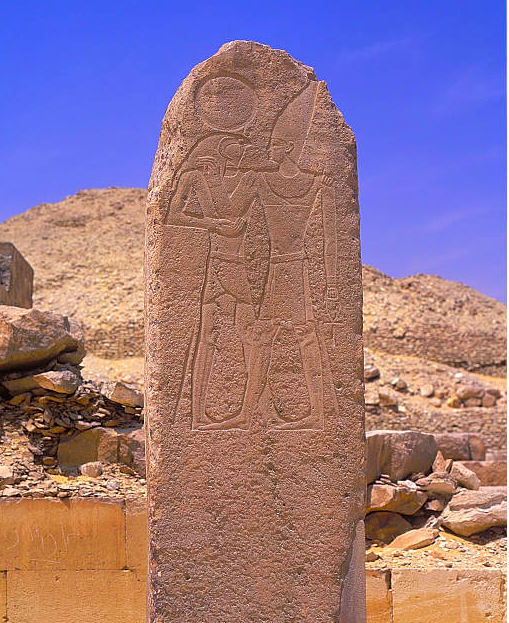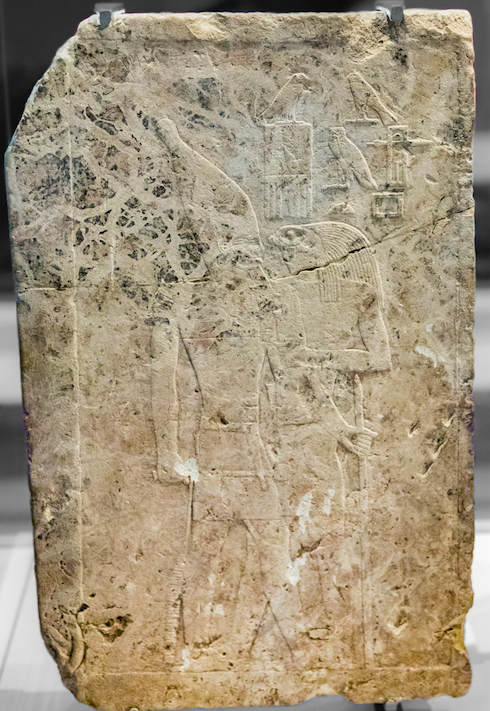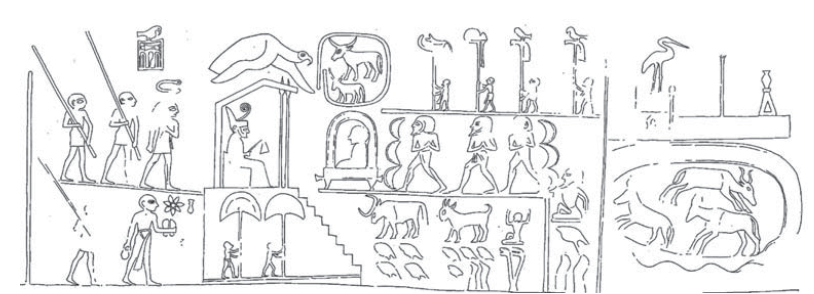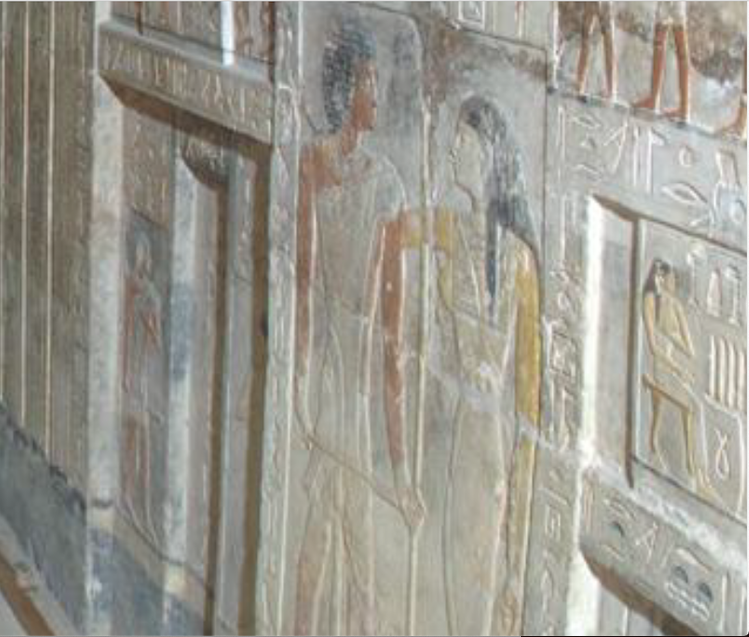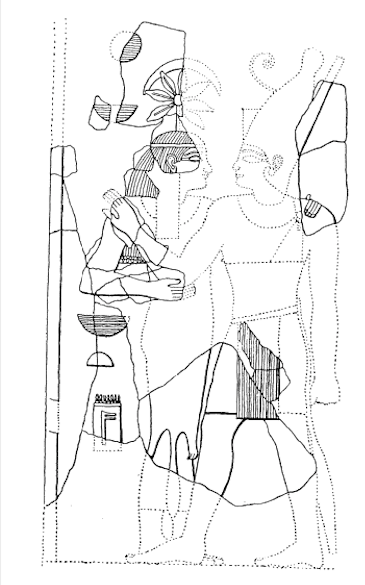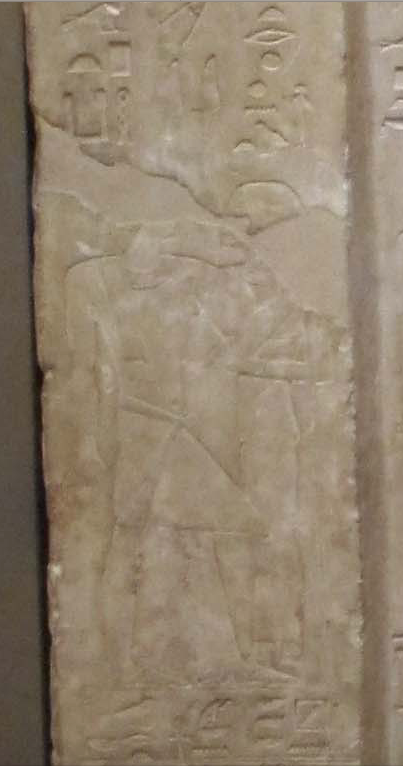Royal throne
Symbolism of egyptian marriage : the royal throne.
Statue in diorite of pharaoh « Khaefrê, Ra, he appears », IVth dynasty, 1m 68 ht, kept in Cairo, discovered by A. Mariette in the pyramid's valley temple.
The throne represents fields, thickets of lis and papyrus/egyptian people of South and of North, on which ones the pharaoh/bird is seated/landed, because this throne has been left empty by Ra who was non more united by knowledge with this thicket/throne/people (TP 267)[1].
The symbolism of « throne nst on earth »/men, appears also in this other formula from Pyramids' Texts (TP 302) whose a composition in chiasmus, highlights the assimilation of throne nst with men [2].
The formula of Pyramid Texts (PT 317) informs us more about the symbolism of the throne.
The formula contains two paragraphs which are each introduced by the same expression « to come (to the wife described by an image/symbol) ».
The first paragraph is a presentation of the divine husband and his filiation. Actually, the god Sobek is described as the one who is « at the head ( = husband) of the Immersed (or immersion, m?t (fem.)) of flood ( = wife, cf. identical description of the spouse further on §508a: « the great immersed ») ».
The folowing description of the god Sobek/N, includes common features with those of his wife because this last formed the body of the husband who was the head/the life (cf. he « makes green the herbage ( = wife) » §509a) : so the greenness ( =life) of his feathers (cf. greenness of the herbs/wife, further), his face (cf. the great eye (jr.t wr.t =wife) §509b) « awake » after the sleep of the death, his front (??.t, fém.) « raised » after the tireness of the death.
Then, the formula goes on by the description of the mother of Sobek/N who « came out of the leg (sbq), the great tail (?sbt Wr.t) », this mother/humanity whose name of the leg, sbq, recalled the one of her son the god Sobek, as to mean the close union of the two, the conjugal union because the qualificatif « great wr.t » given to the mother corresponds to the one of the wife further on (great immersed, great eye). This qualiliy signifies the universal aspect of the wife/mother as humanity.
The second paragraph is a description of the wife. It offers a developpement about the meanings of the words « st, place, trône », employed three times to mean each time, the wife/humanity of god Sobek/N. in different and more and more precise contexts, to make anderstand until what point the god Sobek/N wanted to marry humanity.
The first time, the word « st place/throne » mean « place of offering, st ?tpw » ( = wife), the « green fields of horizon », « the great eye, jr.t wr.t (fem.) » ( = égyptian people), which the god made green/living thanks to « his coming (=union) ». The god unites then to his wife/throne/people, in a way which he will precise by taking for the second time, the word « throne/place st ».
This time, the word place/peuple désignates a place which is received by the god to dispose of his limbs, i.e. of his citizens forming his own body/wife. This union allowed the god to eat, to beget.
But the god will go further in his desire of union with humanity. Not content to generate human beings via his throne/wife/humanity/his own body, he will enjoy the fact that human wife représented humanity and that the husband symbolised the god, to substitute himself to this last and take successively individual wifes to the place/throne he loves », i.e. to the place/throne of wife of God/N (third and last use of the word place/throne, st). The god will then give to this individual wife/throne/field, the « seed of god » (PT 215, 325), « seed of Osiris » (PT 219, 576) « seed of Ra » (PT 576), « seed of de Geb » (PT 303), « seed of the spirit akh » (PT 479), « a son of god, s? n?r » (PT 334, 471, 569 §1438c), « the son of Rê » (PT 467, 575, 691A), a « brother » for the « gods » (=deified men) » PT 200, 302 §460, TP 606)[3].TP 669, TP 649[4]) TP 701A TP 468[5] TP 335[6], TP 337[7] TP 415[8] TP 478[9] TP 506, TP 691B[10], the future pharaoh who will be, since conception, both man and god (cf. forthcoming paper).
PT 317
W/C/W 8
§507a N has come today (ou ici) (jy~n N mjn)
at the head of Immersed of flood (m-?nt m?t ?gbj).
§507b N is Sobek (N pj Sbk),
whose feather are green (w?? šwt),
whose face is awake (rs ?r),
whose front is raised (?z ??t),
§507c The raging came out of the leg (šbš pr m sbq),
the great tail who is in the light (?bzt wrt jmyt j??).
§508a N has come to his canals (jy~n N r mrw=f)
which are in the bank of the inundation of the great Immersed (jmyw jdb ?gb m?t wrt),
§508b to the place st of offering, whose fields are green, and which is in horizon (r st ?tpw, w??t s?(w)t, jmyt ??t) ;
§509a so that N makes green herbage on the two banks of horizon (sw?? N sm ?r jdbwy ??t)
§509b that N could bring greenness (faïence) to the great eye who is in the middle of the field (jnt N ??nt n jrt wrt ?r-jb s?t)
§509c that N receaves his place St (=trône) which is in horizon (šsp N st=f jmyt ??t)
§510a That N appears as Sobek, son of Neit, (?? N m Sbk s? Nt
§510b that N eats with his mouth, that N urinate (wzš N), that N copulate with his penis (m ?nn=f).
§510c N is the lord of seed, (N pj nb mtwt),
who takes the wifes from their husband (j? ?mwt m-? hj=sn)
§510d to the place st that N loves (r st mrr N),
according to his heart (?ft jb=f).
Likewise in the Love's Songs, there is an allusion to the succession of pharaohs/«brothers» who will marry (litt. will come to) the young girl/Egypt :
P. Chester Beatty I, stance 4
« (She, the sister/humanity/Egypt) it has escaped, my heart, in a hurry, (jfd(=w) jb=j ?s)
since I think to your love (?r s??=j (m) mrwt=k).
(…)
Don't be stupid, my heart (physical) (m-jr n=j p?y=j ??ty w??,) :
Why do you make the fool (j.jr=k ?n ?r j?)?
Sit down, be quiet (fresh) and the brother will come to you (?ms qb, jwt n=k sn)
and many other equally (jrt qnw m mjtt) (...)»
Laure de Lamotte©
[1] TP 267
W/A/S 24 T/A/S 6 P/A/S 5 M/F/Sw i 1 N/F/Se B 87
« <§366b> Il (=N) vole en tant qu’oiseau (jp?=f m ?pd),
et il se pose en tant que scarabée (?nn=f m ?pr),
sur le trône (nst) vide qui est dans ta barque, O Rê (m nst šwt jmyt wj?=k, R?)
<§367a> Debout (Rê), retire-toi, toi qui ne connait plus (=n’est plus uni) de fourré de roseaux (??? jdr ?w j?m j?wt),
que ce N puisse s’assoir sur ton siège st (=fourré de roseaux/hommes) (?ms W pn m st=k) ».
[2] TP 302
W/A/N 1 T/A/N 1 P/A/N 7 N/F/Se F 91
§458d La maison de N dans le ciel ne périra pas (n sk pr N r pt),
le trône nst de N sur terre/pays ne sera pas détruit (n ?tm nst r t?);
§459a Car les hommes (cf. terre) se cachent (d?r=sn rm?)
les dieux (cf. ciel) volent (p?y r=sn n?rw);
[3] Les deux ennéades sont vraiment joyeuses (j???) de te rencontrer (m ‘sf k(w), père Osiris N,
et ils disent :
’un frère est venu là à nous’ (jr n=n sn nn), disent les deux ennéades à propos d'Osiris le roi, père Osiris N.
‘ L'un de nous est venu à nous ’ (jy n=n w? jm=n), disent-elles les deux ennéades à propos de toi, père Osiris N.
‘ le fils aîné de son père est venu à nous‘ (jy n=n s? wr n jt=f), disent-elles les deux ennéades à propos de toi, père Osiris N.
‘ Le premier né de sa mère ’ (wtwt n mwt=f), disent-elles les deux ennéades à propos de toi père Osiris N.
[4] TP 649 : « O Osiris le roi, Geb t'a donné tous les dieux de Haute et de Basse Égypte qu'ils puissent te porter et que tu puisses disposer (F/Ne B v 82) d'eux.
Ils sont tes frères en leur nom de chapelle-Snwt ».
[5] TP 468: « §904 o roi, ton ba (tu es un ba, sois un ba) est tel les bas de On,
ton ba est tel les bas de Nekhen,
ton ba est tel les bas de Pe,
ton ba est tel une étoile vivante sb? ?n? à la tête de ses frères; (b?=k sb? ?n? js, ?ntj snw=f) »
[6] TP 335: « son plumage étant son pagne shendjwt en tant qu’Hathor, le plumage d'un faucon (šwt=f m šwt bjk),
de sorte qu'il sort vraiment au ciel parmi ses frères les dieux (pr=f rf jr pt mm snw=f n?rw).
[7] TP 337 : « quand il part au ciel (šm=f rf jr pt) parmi ses frères les dieux (mm snw=f n?rw)
[8] TP 415: « (Tait) toi qui a réconcilié le dieu avec son frère (snsn n?r r sn=f) »
[9] TP 478: « Aimez que N vienne parmi vous, ses frères les dieux (jmr jyw N mm=?n snw=f n?rw);
Réjouissez-vous de rencontrer N, frères de N, les dieux (j??y m ?sfw N snw N n?rw)
comme Horus s'est réjoui de rencontrer son oeil (mj ??t ?r m ?sfw jrt=f)
quand son oeil lui a été donné devant son père Geb (dj n=f jrt=f m-??? jt=f Gb ».
[10] TP 691B : « Les deux bacs de roseaux sont placés pour N, qu'il puisse s'élever de l'Est à l'Ouest parmi ses frères les dieux (m-?b snw=f
n?rw), son frère est Orion, sa soeur est Sothis, et il s'assoit entre eux dans ce pays à jamais.
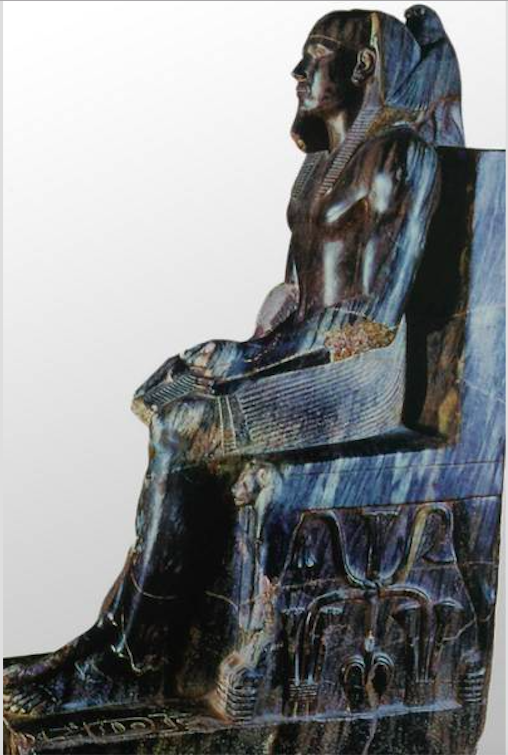
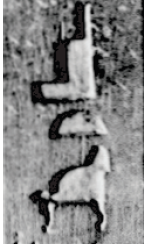
Last edited: 24/05/2021
Add a comment


